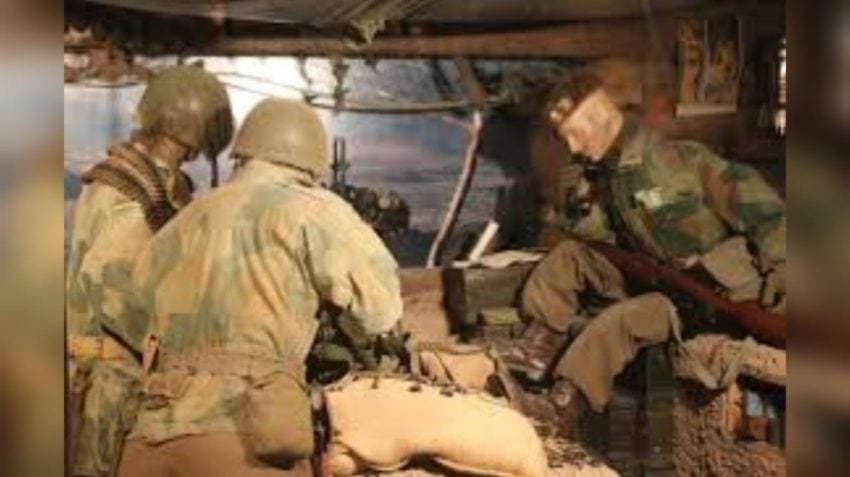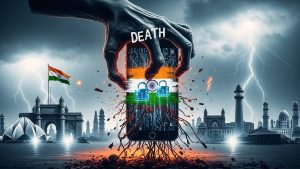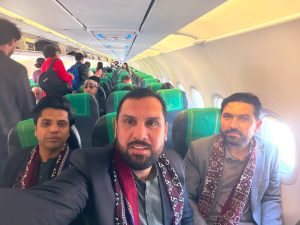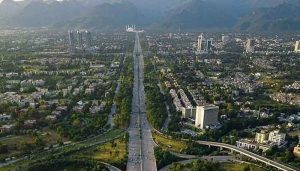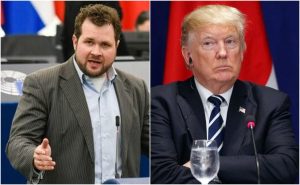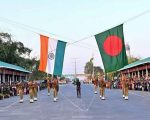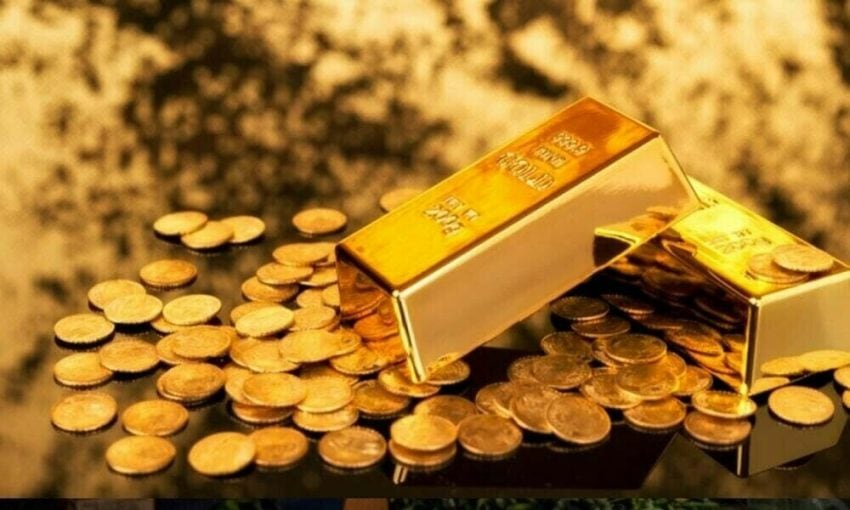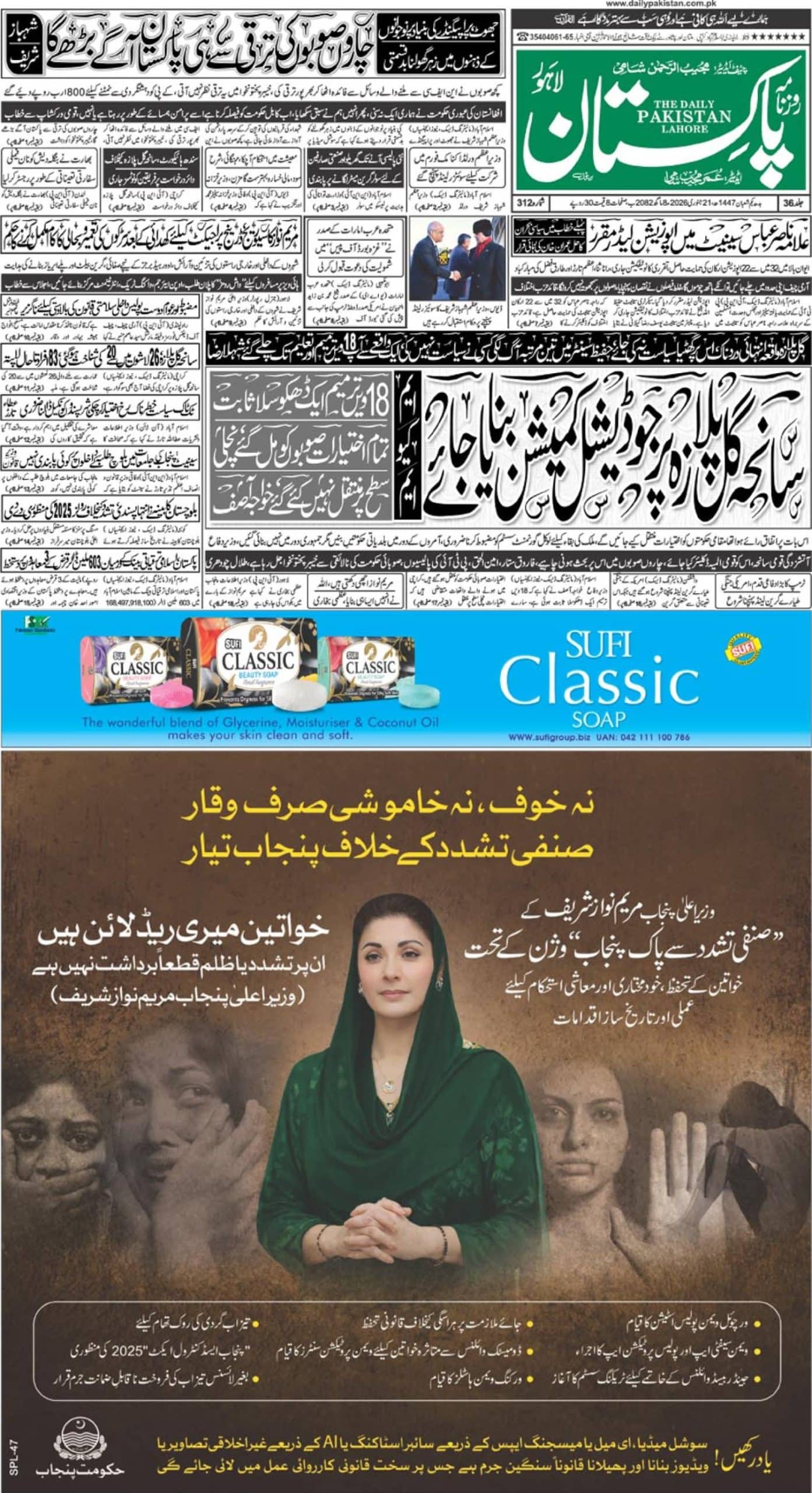The Korean War fought between Communist forces of North Korea, the U.S. puppet regime of the South and eventually involving the U.S. through the U.N. and the People’s Republic of China, was a brutal genocidal war, which has been consigned to well-thought-out oblivion by the Anglo-American Establishment. The Korean war broke out on the night of June 24 and 25, 1950 when the forces of Kim Il Sung attempted to unify Korea within one month. They almost succeeded. U.S. intervention, backed by the UN, eventually stopped and reversed the tide. The Chinese then entered the war against the advice of Stalin. The war ended on 27 July 1953 with an armistice. The South Koreans (ROK – Republic of Korea) never signed a treaty with the North Koreans (DPRK Democratic People’s Republic of Korea).
Were it not for the U.S. intelligence officer Col. L. Fletcher Prouty, nobody would have known that the Korean and Vietnam wars were planned during the dying days of WWII. It was Prouty who first wrote about Churchill’s extremely important statement regarding the High Cabal. Prouty narrates that at the height of WWII, Churchill, upon hearing of the bombing of Rotterdam, remarked: “Unrestricted submarine warfare, unrestricted air bombing . . . this is total war. Time and the ocean and some guiding star and High Cabal have made us what we are.” The High Cabal is a set of the wealthiest families on the planet that operate in complete and sinister secrecy and anonymity, and who have amassed their huge wealth through instigated wars and usurious lending to warring nations. Churchill knew of the High Cabal because he was their asset. It was the High Cabal that had planned the Korean and Vietnam wars in the dying days of WWII. The great bloodshed of WWII had not yet ended when they had begun planning the next one.
Despite enormous damage done to Japan by aerial bombardment, invasion of Japan was considered essential to secure “unconditional” surrender. Thus when the island of Okinawa became available as a launching pad for such an invasion, supplies and equipment for half a million men was piled up in Okinawa. The use of the atomic bombs on Hiroshima and Nagasaki secured unconditional Japanese surrender rendering the piles of equipment on Okinawa Island redundant. Prouty happened to be on Okinawa Island on the date of the Japanese surrender. He narrates “Almost immediately, U.S. Navy transport vessels began to show up in Naha Harbor, Okinawa. This vast load of war material was reloaded onto those ships.”
During some business at the harbor, Prouty casually asked the harbormaster if the material was being loaded for return to the United States. He writes that he was surprised by the direct response of the harbormaster: “Hell, no! They ain’t never goin’ to see it again. One-half of this stuff, enough to equip and support at least a hundred and fifty thousand men, is going to Korea, and the other half is going to Indochina.” Prouty notes: “In 1945, none of us had any idea that the first battles of the Cold War were going to be fought by U.S. military units in these regions beginning in 1950 and 1965 – yet that is precisely what had been planned, and it is precisely what happened.” The natural question that arises is who decided that the equipment be sent to these regions? Prouty asks: “Who made that decision back in 1943-45? Who selected Syngman Rhee and Ho Chi Minh to be our new allies as early as mid-1945?” Referring to the High Cabal as the power elite Prouty writes: “This is another one of those windows that permits us to see that some decision had to have been made in some detail by the power elite, yet there is absolutely no record of who made the decisions and for what purpose.” The information provided by Col. Prouty must never be lost sight of when discussing the Korean and Vietnam wars and the assassination of John F. Kennedy.
The High Cabal considers the entire globe with all its resources as “real estate”, meant to be captured by force or otherwise, and to be put to use for their profits. The High Cabal also believes in a Malthusian philosophy. In the words of Col. Prouty: “The Malthusian theory thus provides a rationalization for the necessity of somehow getting rid of large numbers of people, any people, in any way – even genocide.” The High Cabal has an argument that runs as follows: “Earth will never be able to support the progeny of so many anyhow. From this point of view, genocide – then as now – is accepted as all but inevitable. Who cares and why be concerned?” Finally the High Cabal has a Darwinian mindset. Those who survive and dominate are the “fittest” and have the right to kill off all other races. The Korean and Vietnam wars reflect the genocidal, Malthusian and Darwinian mindset of the High Cabal. The same is true of the post 9/11 wars in the Middle East.
On the day after the atom bomb was dropped on Hiroshima, Rockefeller agent John J. McCloy in the War Department held a meeting with Truman’s foreign policy advisor Dean Acheson and Charles Bonesteel of Pentagon to discuss the division of Korea which had been under Japanese occupation. They chose the 38th Parallel as the dividing line because it included the city of Seoul. The Soviet troops entered North Korea on August 8 and seem to have accepted the 38th Parallel as the dividing line. As a result Korean occupation by Japan was replaced by occupation by the U.S. and the Soviet Union. The U.S. forces entered South Korea on September 8, 1945 and soon occupied it south of the 38th Parallel.
The United States established a military government in South Korea. Its intelligence agents picked up several hundred Koreans, who had been Japanese collaborators, to aid the U.S. in running South Korea. The occupation of Korea by the Soviet Union and the United States was occupation of a country that was not a belligerent. Korea was not at war with the Allies or any other party. Thus the end of WWII resulted in the replacement of Japanese occupation of Korea by the U.S. and the U.S.S.R. It also resulted in a division of Korea along the 38th Parallel.
Bruce Cummings writes in his book The Korean War that within three weeks of the start of the war a Chinese military intelligence group arrived in Pyongyang. Further, as early as August 4, Chairman Mao decided that if the Americans were to invade the North, China must come to the aid of the North in the name of a volunteer army. When, in mid-September 1950, General MacArthur masterminded the Inchon amphibious landing employing 270 ships, a high level North Korean officer requested Chinese help. On October 1, 1950, Kim Il Sung met the Chinese ambassador to request that the 13th Army Corps of the PLA come to their aid by crossing the Yalu River. Stalin opposed a major Chinese involvement fearing wider war, but Mao went ahead, much to Stalin’s surprise, and sent twelve infantry divisions to help the North Koreans. Stalin, however, backed off from a promise of air cover and that paved the way for aerial genocide of Koreans by the USAF. Apparently the October 1, 1950 crossing of the 38th parallel by the Chinese caused Mao a sleepless night, but he went ahead and informed Stalin the next day. Mao’s decision to back Kim ll Sung was based upon Mao’s straightforward determination that if the Korean struggle faltered, China was bound to support the Korean Communists in view of their great sacrifices during the Chinese revolution and their resistance against the Japanese.
As early as October 1950, General George Stratemeyer of USAF sought permission to attack a provincial capital Sinuiju. The city of Sinuiju had a population of around 60,000 and Strtaemeyer wanted to bomb “over the widest area of the city, without warning, by burning and high explosive”. Such was the inhuman and genocidal mindset of the American establishment. Gen. MacArthur denied this request initially. However, on November 3, 1950, MacArthur agreed to a firebombing campaign, accepting Stratemeyer’s request to burn Kanggye: “Burn it if you so desire. Not only that, Strat, but burn and destroy as a lesson to any other of those towns that you consider of military value to the enemy.” The firebombing of Sinuiju was also approved on November 3, 1950. The instructions were noted in summary in Stratemeyer’s diary as follows: “Every installation, facility, and village in North Korea now becomes a military and tactical target.” Stratemeyer gave the following inhuman orders to his bombers: “[D]estroy every means of communications and every installation, factory, city, and village”. Two days later, on November 5, Stratemeyer ordered the destruction of “all other targets including all buildings capable of affording shelter.” On that day, 75% of the city of Kanggye was destroyed by USAF bombers! These massive war crimes against civilian populations of North Korea were committed by the U.S. with impunity. North Koreans have done well not to forget this inhumanity.
The Allied forces had discovered during WWII that it was easier to burn down a city than to blow it up. Thermite sticks bundled together in millions supplemented by mixtures of benzene, phosphorous and other things were employed to set cities on fire. The resulting firebombs could set cities ablze and incinerate them in minutes. On March 16, 1945, the city of Wurzburg was burnt in a mere seventeen minutes! The development of firebombing represents perhaps the most painful, inhuman and sadistic development in aerial warfare. When Dresden was firebombed one eye witness who survived described “young women carrying babies running up and down the streets, their dresses and hair on fire, screaming until they fell down, or collapsing buildings fell on top of them.” Firebombing was conceived and developed by the brutal and utterly inhuman Anglo-American alliance. It burns innocent civilians and is a war crime of the highest magnitude.
The American military leaders decided to repeat the firebombing of WWII in North Korea. Germans had an air force and effective anti-aircraft fire that caused significant losses to Allied forces. But North Korea did not have any air force and thus had no air cover. Under these circumstances the bombing and firebombing of North Korea was a one sided affair. Not only was it one sided, the Americans dropped more bombs on North Korea in less than three years than the bombs used in the Pacific theater during the entire WWII. In the Pacific theater the Allies dropped 503,000 tons of bombs during WWII. The U.S. dropped 635,000 tons of bombs on North Korea and an additional 32,557 tons of napalm! Please note that napalm burns at temperatures ranging from 800 to 1200 degree Centigrade. It burns longer than gasoline and adheres to its targets making death much more painful for the victims.
The USAF seemed to have a penchant for napalm bombs because they inflicted the greatest possible pain on their unfortunate victims. General Ridgeway wanted heavier and better napalm bombs. He desired thousand pound versions to be dropped on targets in 1951. The object was to “wipe out all life in tactical locality and save the lie of our soldiers.” On one occasion when American soldiers fell victim to “friendly” fire of napalm, their suffering was described by a witness James Ransome. His men rolled in agony in the snow and begged him to shoot them because the burning of their skin by napalm was unbearable. Their skin burned and peeled back “like fried potato chips”. This was the wonder weapon of the USAF!
Gen. Curtis LeMay, who, in the humble opinion of this author was too trigger happy and brutal to be entrusted with serious responsibility, and who may have played a minor role in the Kennedy assassination, wanted to burn down the big cities of North Korea at the very beginning of the war. The Pentagon ruled that “it’s too horrible”. Yet, in an oral history record, LeMay stated that over a three year period “We burned down every town in North Korea, and South Korea too . . . Now over a three year period this is palatable, but to kill a few people to stop this from happening – a lot of people can’t stomach it.” Such was the nature of attacks on the cities and towns of Korea that no sane person can stomach it. On July 11, 1952 a total of 1,264 air sorties over Pyongyang were carried out by B 29 bombers during daytime, followed by 54 sorties at night. Imagine what the residents of this city went though. Imagine the inhumanity of the Anglo-American Establishment, the champions of human rights, democracy and all that crap. The attack on Pyongyang was to be followed by similar attacks on thirty other cities and industrial centers as part of operation “Pressure Pump”.
Col. Fletcher Prouty has noted: “There had been a Malthusian movement, concealed at all times from the public, to uproot and destroy the existing and traditional system of communal spciety in many parts of the world. The activists of this movement fear the strength of the peasant and the ways of peasant life. They much prefer a society of dependent consumers. Indochina and Korea were the prime targets during the post-World War II decades.” Bruce Cummings has noted: “Korea recapitulated the air force’s mantra from World War II, that firebombing would erode enemy morale and end the war sooner, but the interior intent was to destroy Korean society down to the individual constituents.”
In May 1952, the great Suiho Dam on Yalu river was attacked. It was second only to the Hoover dam in the entire world. However, for fear of provoking the Chinese and Russians it was not demolished. In order to deprive the North Korean population of the 250,000 tons of rice that was to be harvested the USAF targeted its dams. In May 1953, soon after rice had been panted, three dams were hit by the USAF bombers. These were the Tukson, Chasan and Kuwonga dams. These were major dams. On May 13, 1953 fifty-nine bombers were used to breach the high wall of Toksan dam. The first breach at Toksan “scooped clean twenty-seven miles of river valley, and sent water gushing into Pyongyang.” The breach in Toksan generated a flood of onrushing water that destroyed “six miles of railway, five bridges, two miles of high way and five square miles of rice paddies.” After the war it took “200,000 man-days of labor to reconstruct the reservoir.”
Gen. William F. Dean was the highest ranking military officer (Major Gen.) to be captured by the North Koreans. When he was released from captivity he narrated that “the town of Huichon amazed me. The city I’d seen before – two-storied buildings, a prominent main street – wasn’t there any more.” Gen. Dean described “unocuupied shells” of “town after town, and villages where rubble or ‘snowy open spaces’ were all that remained.” The destruction caused by US. Bombing was total and ubiquitous. The Hungarian writer Tibor Meray told a Thames TV team: “I saw destruction and horrible things committed by American forces.” As he said:”Everything that moved in North Korea was a military target, peasants in the fields were often machine gunned by pilots who, this was my impression, amused themselves to shoot the targets which moved.” Such was the scale and nature of inhumanity of the Americans.
In his book Bruce Cummings has cited Meray, who arrived in Korea in August 1951 to witness “a complete devastation between the Yalu River and the capital” {Pyongyang). Meray states that there were just “no more cities in North Korea.” Because of continual bombing their party was compelled to travel by night. Meray states: “We traveled in moonlight, so my impression was that I am traveling on the moon, because there was only devastation . . . every city was a collection of chimneys. I don’t know why houses collapsed and chimneys did not, but I went through a city of 200,000 inhabitants and I saw thousands of chimneys and that – that was all.” The absolute and inhuman and criminal destruction of North Korean cities has been concealed from the world and the insouciant U.S. public.
Such was the scale of barbarity and brutality of the U.S. forces that eighteen out of twenty two major cities of North Korea were obliterated. A partial table has been provided by Cumings. The percentage of destruction of seven cities has been given as follows: Pyongyang 75%, Chongjin 65%, Hamhung 80%, Hungnam 85%, Sinanju 100%, Sariwon 95%, and Wonsan 80%. Cumings quotes an official American history source: “So, we killed civilians, friendly civilians, and bombed their homes, fired whole villages with the occupants – women and children, and ten times as many hidden Communist soldiers – under showers of napalm, and the pilots came back to their ships stinking of vomit twisted from their vitals by the shock of what they had to do.”
On March 10, 1951 Gen. Douglas MacArthur requested “’D’ Day atomic capability” to retain air superiority in the war. The request was made in view of intelligence information that the Soviet Union was ready to move its air divisions into Manchuria, in the vicinity of Korea, coupled with the massing of huge Chinese forces near the Korean border . These Soviet air divisions could strike, not just targets in Korea, but also U.S. bases in Okinawa. By the end of March 1951, atomic bomb loading capabilities an air base in Okinawa wee operational. Around this time Gen. MacArthur was removed and in the ensuing confusion, an April 6 order of President Truman, ordering use of atomic weapons against Korean and Chinese targets was never transmitted! Reviewing A.B. Abram’s 2024 book Surviving the Unipolar Era, Richard C. Cook writes: “During the war, U.S. commander Douglas MacArthur recommended nuclear strikes against 26 Korean and Chinese targets. These were deterred by the Soviet Union’s possession of a nuclear strike capability that could be used against American East Asian bases. The Korean War also led China to believe it needed a nuclear deterrent against the U.S.”
Operation Hudson Harbor sought to establish the capability of using nuclear weapons in the battlefield in Korea. As late as September and October 1951 B-29 bombers wre sent over Korea simulating atomic bomb runs. These planes were loaded with dummy A bombs or heavy TNT bombs. Thus, in 1951, the possibility of use of nuclear weapons in Korea was serious. The project seemed to indicate that nuclear weapons might not be useful simpy because timely identification of large numbers of enemy troops was extremely rare. Cummings notes: ”But one can imagine the steel nerves required of leaders in Pyongyang, observing a lone B-29 simulating the attack lines that had resulted in the devastation of Hiroshima and Nagasaki just six years earlier, each time unsure whether the bomb was real or dummy.”
In 1950 the total population of Korea was around 31.1 million. Of this 20 million resided in South Korea and the remaining 11.1 million in North Korea. A B Abrams pointsout that “Altogether, three to four million North Koreans died in the war, a number declared by many observers to be genocidal.” Additionally about six million became homeless. Thus about one third of the Korean population was either killed or became homeless. This massive human tragedy was caused by a power drunk, Malthusian and inhuman U.S. Establishment. The Anglo-American Establishment, working for the international banking families, is the greatest criminal and genocidal force in the entire annals of human history. Their crimes by far surpass any crimes against humanity committed by any other force in history.
The North Koreans have never bowed before the United States. They have surived the collapse of the Soviet Union in the 1990s, followed by disasters, likely US manipulated, that brought it to the brink of starvation. It has been a at war with the US and its lackeys for 75 years now because there never was a peace treaty and a state of war persists. Faced by persistent U.S. attempts to destroy it North Korea has developed massive underground fortifications and a deterrent capability of dropping H bombs on U.S. mainland. It has thus forced the U.S. to back down in its attempt to attack North Korea. Hats off to the leadership and people of North Korea.

